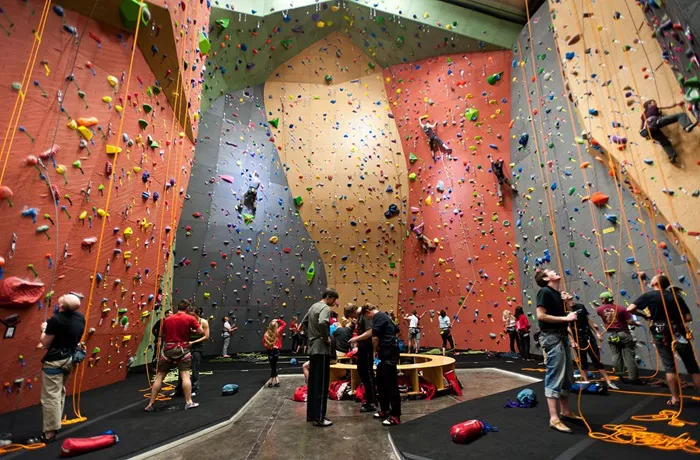Indoor rock climbing is an exhilarating sport that demands both physical prowess and the right attire. Proper clothing and equipment can significantly enhance your performance, comfort, and safety while climbing. This comprehensive guide will cover everything you need to know about what to wear for indoor rock climbing, from selecting the best climbing shoes to choosing the right clothing and accessories.
How to Choose the Right Climbing Shoes
Why Proper Fit Matters
Climbing shoes are arguably the most crucial piece of equipment for any climber. They provide the grip and support needed to tackle climbing routes effectively. A proper fit is essential—shoes should be snug but not painfully tight. A well-fitting shoe will help you make precise movements while ensuring comfort during extended climbing sessions.
Types of Climbing Shoes
Understanding the different types of climbing shoes can help you select the best one for your needs:
- Neutral Shoes: These shoes are designed for comfort and versatility, making them ideal for beginners and climbers who engage in various climbing activities.
- Moderate Shoes: With a slight downturn, moderate shoes balance comfort and performance, making them suitable for multi-pitch climbs and sport climbing.
- Aggressive Shoes: Featuring a significant downturned shape, aggressive shoes are designed for high-performance climbing, offering enhanced precision for technical routes.
Material Considerations
Climbing shoes are generally made from leather or synthetic materials. Leather shoes mold to your feet over time, offering a custom fit. Synthetic shoes, on the other hand, are resistant to stretching and maintain their performance characteristics throughout their lifespan.
How to Select the Appropriate Climbing Harness
Different Harness Types
A climbing harness is crucial for safety, as it connects you to the climbing rope and provides protection during climbs. There are two main types of harnesses:
- Full-Body Harnesses: These harnesses offer complete coverage and are often used for children or climbers requiring extra security.
- Sit Harnesses: Most commonly used for indoor climbing, sit harnesses support the waist and thighs, with adjustable leg loops and waistbands for a customizable fit.
Key Features to Consider
When choosing a climbing harness, look for the following features:
- Padding: Adequate padding ensures comfort, especially during long climbing sessions.
- Adjustability: Ensure the harness is adjustable to fit different body sizes and shapes.
- Gear Loops: Look for harnesses with gear loops to conveniently carry essential climbing equipment such as carabiners and quickdraws.
What Clothing is Best for Indoor Climbing?
Importance of Breathability and Flexibility
Indoor climbing requires a full range of motion, so it’s important to wear clothing that is both flexible and breathable. Materials that wick moisture away from your body help keep you dry and comfortable. Popular choices include:
- Synthetic Fabrics: These are lightweight, moisture-wicking, and quick-drying, making them ideal for climbing.
- Stretch Fabrics: Fabrics with elastane or spandex ensure freedom of movement without restricting your climbing performance.
Layering for Comfort
Since indoor climbing gyms can have varying temperatures, layering is essential. Start with a moisture-wicking base layer, add a mid-layer for insulation if needed, and finish with a lightweight, breathable outer layer. This allows you to adjust your clothing based on your comfort level and the gym’s climate.
Avoiding Distractions
Choose clothing that does not interfere with your climbing performance. Avoid overly loose garments that could catch on climbing holds or harnesses. Opt for well-fitted, streamlined clothing that allows for a full range of movement without being cumbersome.
What Accessories Are Essential for Indoor Climbing?
Chalk and Chalk Bags
Chalk is essential for maintaining a good grip and preventing your hands from slipping due to sweat. A chalk bag helps you carry and access climbing chalk easily. When selecting a chalk bag, look for one with a secure closure and a brush holder for cleaning climbing holds.
Climbing Tape
Climbing tape is useful for protecting your fingers and hands from injuries and calluses. It can also reinforce climbing shoes and secure loose gear. Keep a roll of tape in your climbing kit to address minor injuries or equipment issues.
Climbing Gloves
While not always necessary, climbing gloves can provide extra protection and improve grip. They are particularly useful for climbers who experience discomfort or abrasions on their hands. Choose lightweight, breathable gloves that offer dexterity without compromising climbing performance.
What Safety Considerations Should You Keep in Mind?
Ensuring Proper Fit
Proper fit is crucial for all climbing gear to ensure both safety and performance. Ill-fitting harnesses or climbing shoes can affect your stability and comfort, potentially leading to accidents or injuries. Regularly check and adjust your gear to maintain a secure fit.
Regular Gear Inspection
Before each climbing session, inspect your gear for signs of wear and tear. Look for frayed harness straps, worn-out climbing shoes, and any other damage. Replace or repair damaged equipment to maintain safety during climbs.
Following Gym Protocols
Adhere to the safety protocols and guidelines established by your climbing gym. This includes proper use of equipment, following belaying procedures, and respecting gym rules. By doing so, you contribute to a safer climbing environment for yourself and others.
see also: How to Handle Loose or Damaged Bolts on a Rock Climbing Route
Conclusion
Choosing the right attire and equipment for indoor rock climbing is essential for maximizing your performance and ensuring your safety. From selecting the appropriate climbing shoes and harnesses to wearing the right clothing and accessories, each element plays a critical role in your climbing experience. By understanding and investing in high-quality, well-fitting gear, you can enhance your climbing journey and enjoy a more comfortable and successful experience.
related topics:
- Which Type of Rock Climbing Is the Safest for Beginners?
- What Are the Different Types of Rock Climbing?
- What Is a Form of Free Climbing Often Done in a Rock Gym

